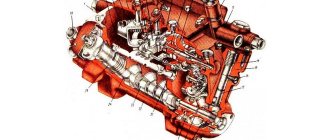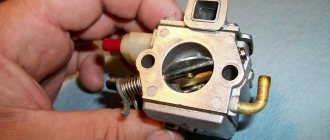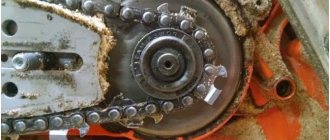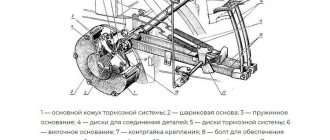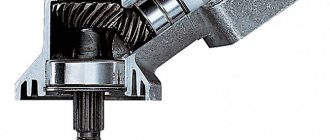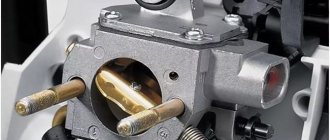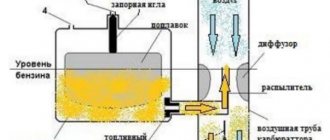One of the most important components of a chainsaw is the clutch or clutch mechanism. When using the tool, this part may fail, which will make it impossible to carry out work on sawing wood. If the clutch mechanism fails, then the question immediately arises of how to remove the clutch on a chainsaw. This need arises when a device needs to be repaired or replaced. How to do this is described in the material.
The design and operating principle of the chainsaw clutch mechanism
Most sawers do not understand how the chainsaw clutch mechanism works. When working, it is not necessary to know the operating principle, but when malfunctions occur, in order to eliminate them, you will need to find out the design and operating features of the chainsaw clutch.
Modern chainsaws are equipped with centrifugal clutch mechanisms. Centrifugal clutch - this means that its performance depends on the torque of the engine. The main purpose of the clutch on a chainsaw is to ensure the transmission of torque from the engine crankshaft to the saw set (chain). The device operates in automatic mode, and we will find out in detail how this happens.
The clutch mechanism consists of the following structural elements:
- A drum with a removable or non-removable sprocket is a transmission mechanism
- Friction linings - move under the influence of centrifugal force, engaging with the drum
- Spring - ensures that the linings are pressed against the crankshaft
Now about the principle of operation of the chainsaw clutch.
When the two-stroke engine of the tool starts, the crankshaft begins to rotate. A coupling is attached to the shaft, to which the chain is connected using a sprocket. When the chainsaw is idling (shaft rotation speed up to 2700 rpm), that is, the accelerator trigger is not pressed, the spring presses the friction linings, as a result of which torque is not transmitted to the drum.
As soon as the sawyer picks up the tool and begins to increase the speed (maximum up to 14,000 rpm), the chain begins to move along the bar. This happens due to the fact that the speed of rotation of the crankshaft increases. Due to the force of inertia, the friction linings (also called counterweights) move and engage with the inner walls of the drum. As a result, the drum moves, which is connected to the sprocket. The rotating sprocket drives the chain.
The principle of operation of the mechanism is simple, which is due to its simple design. If this part fails, then the chainsaw will not work. A detailed description of the operating principle of the chainsaw clutch mechanism is described in this material.
This is interesting!
The clutch serves not only as a transmission mechanism, but also as a protective device. It protects the chainsaw engine from premature failure when the chain gets jammed in the wood being cut.
Can The Saw Work Without Primer Cap
Chainsaw malfunctions and repairs
A chainsaw is not such a complicated device. But for which the fault detection design is intended, you need to have at least basic knowledge in order to find and remove the defect that appears.
It is necessary to consider the main malfunctions of chainsaws, find out what they are connected with, and also analyze the main steps to correct the breakdowns.
And the most important thing before starting repairs is to correctly identify the fault. And there may be several reasons for the inoperability of each element. Therefore, before you start disassembling the chainsaw, you need to try to find what is causing the refusal of work.
You know, a failure during operation of chainsaws can be caused by a malfunction of the motor or the appearance of breakdowns in its other components.
Motor malfunctions include:
- ignition fault;
- problems in the fuel supply system;
- piston malfunction as it is also called cylinder.
In other components, in most cases, malfunctions appear due to failures of the brake mechanism and lubrication system
, operation of the clutch, tires, etc.
It is necessary to consider both groups of defects so that you can, if necessary, find the cause of the breakdown on your own without contacting a repair shop.
Engine malfunctions
When operating the motor, in most cases the following disadvantages are observed:
- the engine does not start at all;
- starts, but immediately stalls;
- does not develop suitable power;
- works unstable.
To find the cause of the problem, it is necessary to analyze the probable preconditions all in order using the method of elimination. Let's go through this chain so that you know how to find a flaw in the chainsaw for which the design of its occurrence is intended.
When is a clutch replacement necessary?
Removing and replacing the chainsaw clutch is carried out if a malfunction of the mechanism is detected. Such malfunctions include:
- Spring damage.
Depending on the model of the tool, the spring can be of two types - coil (band or single) or steel plate. The spring is damaged by stretching, separation, or mechanical failure. To determine the cause of the malfunction of the entire mechanism, you will need to remove the protective casing and drum - Drum damage and wear.
Failure of this part is often associated with pieces breaking off. If such a malfunction occurs, the drum will need to be replaced. The inside of the drum also wears out, so the part also needs to be replaced. If the drum is blue, this indicates that it has been overheated and cannot be used for further use. - Development of the mechanism.
It is connected primarily with the stretching of the spring, which can be replaced. The threaded connection also wears out. If such a breakdown occurs, the entire coupling will need to be replaced. - Sprocket wear.
Depending on the type of sprocket (collapsible or non-dismountable), it is replaced along with the drum and, if necessary, a coupling
The service life of the clutch mechanism depends not only on the quality of the components, but also on the correct operation of the tool. To extend the life of the chainsaw clutch, you need to pay attention to signs that reduce the resource. These signs include:
- Frequent snagging or biting of the chain in the wood. In such situations, the clutch takes on the entire load, thereby protecting the engine from jamming
- It is forbidden to increase the speed when the handbrake is on, which also leads to wear on the mechanism due to overheating
- Use of low-quality oil, incorrect choice of tire, chain, etc. All this also affects the clutch, increasing the load, and thereby reducing the service life
Determining a device malfunction is quite simple. To do this, you need to cut the workpiece. If during the sawing process the rotation speed of the chain decreases or it stops when the load increases, then it’s time to check the clutch. We will consider in detail how to remove and replace the clutch on a chainsaw in the next section.
This is interesting!
You can check the suitability of the compression spring by connecting a tachometer to the tool. At idle, you need to turn up the number of 2500-2700 revolutions per minute on the tachometer. At this value, the chain on the chainsaw should not rotate. If a different picture is observed, then this indicates a decrease in the compressive properties of the spring. It is recommended to replace it. Based on this, it should be noted that the chainsaw clutch is in close relationship with the carburetor. If you cannot adjust the idle speed on the chainsaw by adjusting the carburetor, then you need to check the serviceability of the clutch.
How to change
In order to replace this mechanism, it is necessary to dismantle the old coupling device. During repair work, the saw must be securely fixed on a non-slip surface using special devices.
When dismantling and installing the clutch, it is recommended to take into account the following nuances of such work:
- On some modifications of the tool, a washer is located between the coupling device and the drive gear cup. Therefore, upon completion of the repair, it is necessary to install this element in place.
- Some oil wires have a special spring. It is mounted between the sprocket and the oil pump drive. It also needs to be reinstalled correctly after replacing the coupling mechanism.
How to remove
In order to remove and disassemble the clutch, you need to place the chainsaw on a flat, non-slip surface and secure it with locking elements.
First you need to unscrew the saw chain and bar using a universal wrench. After this, you can remove the cover from the air filter element. Then you need to remove the spark plugs and fix the piston part in the master cylinder.
After this, install a suitable puller and unscrew the clutch.
After these steps, remove the clutch drum on the chainsaw and the clutch. At the end, you can conduct an external inspection of the system for damage and defects and, if necessary, replace failed parts with new ones.
How to assemble
In order to reassemble the mechanism, it is necessary to replace the coupling and secure it with a special handle. The saw engine must be turned off at this moment.
Afterwards, you can reinstall the spring device, drum mechanism and sprockets.
Then you can install the clutch mechanism back into the tool body, remove the crankshaft from the stopper, install the filter mechanisms, throttle valve and pitch along with the chain in place.
At the end of the work, it is recommended to start the chainsaw and check the functionality of the assembled clutch. If all parts are installed correctly, the clutch will engage immediately and there will be no delays or leaks.
Removing and replacing the coupling with your own hands according to the instructions
Not many sawmills know how to remove the clutch on a chainsaw. The design of the mechanisms on different models of chainsaws differs, but the principle of operation is the same everywhere. The dismantling procedure is also almost identical, so next we’ll look at how to unscrew the clutch on a chainsaw with an internal sprocket.
First you will need to prepare the necessary tools:
- A special key called a puller. It often comes with a chainsaw
- Screwdriver for removing the screws that secure the protective cover
- Spark plug wrench - used to unscrew the fastening of the casing and tire (included with the tool)
- Rope - to stop the crankshaft. It is better to use asbestos, but any will be suitable for this purpose. A rope is used in case the tool does not come with a special piston locking wrench.
If dismantling is carried out for the purpose of replacement, then accordingly you will need to prepare a new mechanism in advance. When purchasing a new coupling, you only need to know the exact brand of chainsaw, since the devices differ in outer diameter, thread and design of the working mechanism. Instructions on how to remove the clutch on a chainsaw are as follows:
- Initially, you need to unscrew the fastening nuts of the casing and tire
- Remove the handbrake housing, as well as the chain and bar
- After that, we proceed to removing the plastic cover to get to the spark plug. To do this, use a screwdriver to unscrew the fasteners and remove the cover along with the air filter.
- The spark plug of a chainsaw is unscrewed using a spark plug wrench
- You need to insert a rope into the spark plug hole of the cylinder (install a special key if available). This is done in order to lock the crankshaft. If the diameter of the rope is several times smaller than the size of the candle hole, you can make knots on it
- Next, we proceed to unscrewing the coupling itself. To do this, we take a special key, which should be included in the kit. If you don’t have a key, you can use a tool from an angle grinder or make your own puller, which is also not difficult
- The key splines must be installed in the coupling holes, and then begin rotating the part. Rotate in a clockwise direction. Manufacturers usually indicate the directions for unscrewing in the form of an arrow.
- As the clutch rotates, the piston will reach top dead center and then lock the crankshaft. Then, by applying a little force, the clutch will break off, followed by unscrewing the mechanism.
- The unscrewed clutch is removed from the chainsaw. If necessary, the drum with the sprocket is also removed
The procedure is not at all difficult and does not take much time. Assembly is performed in the reverse order of removal. To avoid any malfunctions, it is recommended to install a completely identical clutch on the corresponding tool model.
This is interesting!
The procedure for removing and replacing the clutch is carried out in a similar way for all brands of chainsaws: Husqvarna, Partner and others.
Fuel system
The electric ignition of a chainsaw contains a flywheel (1) with built-in magnets, an ignition module (2) with an electrical circuit, a spark plug (3) and a high-voltage wire (4). A rotating flywheel with magnets induces an emf in the module, which is converted by an electrical circuit into electronic signals supplied to the spark plug. As a result, a spark jumps between the contacts of the latter, igniting the air-fuel mixture.
So that as the fuel mixture is used up, the fuel tank is filled with air and negative pressure is not created in it, which will prevent fuel from flowing from it into the carburetor, and at the same time, so that fuel does not flow out of the air hole, in the cap covering the filler hole, breather made. How to replace oil seals on a chainsaw. How to remove the sprocket, clutch and flywheel. And by the way, if the breather becomes clogged with dirt, the chainsaw will stall.
Currently reading: Circular saw Interskol
Preparatory filters can have different designs and consist of several parts, namely, a mesh (2) and a snow (1) filter (see photo below).
In some models of chainsaws, at the preparatory cleaning stage, air is purified using centrifugal forces. The air flow is twisted by the flywheel impeller, as a result of which impurities are thrown away from the absorption pipe leading to the narrow filter.
Narrow filters are made of diffusion foam rubber, nylon mesh and other materials.
When a chainsaw is operating, the air in the area where it operates can be very dirty with sawdust and wood dust. Excessive filter contamination reduces the volume of air entering the carburetor, which leads to a richer consistency and a decrease in the power of the chainsaw. Removing the clutch from a partner p340s chainsaw. How to remove the clutch on a chainsaw.
Therefore, constant cleaning of the filter is necessary. It should be carried out not only when the chainsaw is disassembled for the purpose of repairing it, but even more often, after any long and dirty work. The clutch burned out, how to change the sprocket on a chainsaw easily without effort and. Cleaning is done in a way that depends on the type of filter material - in most cases, by blowing and washing.
Removing the clutch on Shtil and Dolmar chainsaws
You've probably noticed that chainsaws can have different designs of transmission devices. Above are instructions for removing the coupling with a drum on which the sprocket is located on the inside. Most chainsaws have such a device, but not Stihl tools. Chainsaws from a well-known manufacturer are equipped with a drum that has a sprocket on the outside. It looks like this, as shown in the photo below.
A different sprocket location does not mean that the tool is equipped with a different clutch mechanism. However, this suggests that the principle of removing the clutch differs from the instructions described above. Therefore, we will find out how to remove the clutch on chainsaws Stihl, Dolmar and others, on which the sprocket is located on the outside.
- To begin, you must also remove the casing and tire to provide access to the clutch.
- Unscrew the spark plug and lock the piston using a special wrench or cord
- Next we proceed to removing the sprocket and drum. To do this, use a screwdriver to pry up the retaining ring and remove it.
- The drum with bearing is dismantled
- Using a “19” wrench (included with the tool), you need to unscrew the nut with a left-hand thread connected to the mechanism. Unscrew in a clockwise direction
- The appropriate repair or replacement of the part can then be carried out.
Installation of a new or repaired part is carried out in the reverse order of removal. The procedure is almost identical to the first option, with the exception of some features. If it is necessary to replace only the drum or sprocket, then you will not need to dismantle the coupling, unlike the option with an internal sprocket arrangement.
This is interesting!
If the drum is replaced, it is also recommended to change the clutch mechanism itself. If the drum is changed due to overheating, then there is a high probability that the mechanism also has properties of damage from exposure to high temperature.
Useful tips from “Kosi Kosa” specialists
KosiKos specialists described the procedure for removing the clutch on a chainsaw step by step. The article also includes a high-quality video so that the user of the tool can imagine all the nuances in detail.
Pay attention to how to lock the piston, in what position it should be so that other parts and your actions do not set it in motion
It is also important not to provoke the movement of the starter, not to break it when installing a new clutch and dismantling the old element
In addition to the main process of “replacing the clutch,” service specialists and specialized stores will give several important tips in the general scheme of the procedure:
When stopping the piston, it is necessary that it passes through the purge windows and carburetor windows before reaching bottom dead center. The piston rests against a rope (or rope), and the latter does not hit, for example, the exhaust windows; remember that all clutches have left-hand threads
It doesn’t matter whether the saw model is a professional one or a household one; before removing the clutch (also known as the clutch drum), it is worth wiping all those places on the saw where the parts were removed - from dust and dirt, which may later be harmful to you; before threading a rope or rope with knots into the piston zone, it must first be moved to the top dead position, then lowered slightly; between the clutch and the drive sprocket cup - some models contain a washer part. After disassembly, it must be installed in the same position as it was.
This is often the area between the cup and the engine; In some models of chainsaws, the oil pump drives contain a special spring. It is this part that transmits rotation from the star to the oil pump. If it is installed incorrectly, the oil pump will not supply lubricant to the chain and saw set; it is important to remove a rope with knots or a thick rope after carrying out work, and in their context do not forget to leave part of the element outside; Please note that Husqvarna saws only have a single clutch spring and two weights attached to it. Shtil already has three springs and three weights. The latter are also called sectors. This must be taken into account when replacing a part, since the opposite option will not perform its functions, or the saw will not start at all.
General important advice includes the recommendation to purchase original parts and spare parts, and not to experiment, even if foreign elements seem suitable at first glance. The clutch works in conjunction with other important chainsaw systems, and their breakdown will be to your disadvantage. One way or another, you can always order any spare part on our website!
The chainsaw clutch drum, also known as the drive sprocket, is a consumable item, so it requires periodic replacement. The main reason for replacement: wear of the sprocket teeth by the saw chain. If the drum is monolithic, then during long-term operation the chain simply cuts through the sprocket and the entire drum needs to be replaced. On some chainsaws, the clutch drum has a replaceable ring, which also wears out. In this case, only the crown is changed; the drum, if it is in good condition, is left for further use.
Many saw owners do not think about how to remove the clutch on a chainsaw themselves, because they have the opportunity to contact a service center. But not everyone has this opportunity, for this we are publishing this article, in which we will explain step by step how to remove the sprocket from a chainsaw.
This operation is not at all difficult if you have the necessary tools and parts at hand. In the article, as an example, all actions are performed with an Echo CS-3500 chainsaw; all operations for replacing the clutch drum for other chainsaws are similar.
First you need to remove the saw set: unscrew the bar cover nuts with a standard universal wrench, and remove the bar and chain.
Remove the air filter cover.
Using the standard universal wrench, unscrew the spark plug.
To fix the piston in the cylinder, instead of a spark plug, we screw in the piston stopper.
We take the clutch puller for this model of chainsaw and install it in the universal key.
Unscrew the clutch clockwise.
Remove the clutch drum.
We replace the clutch drum or ring with a new one, and check the condition of the clutch separator. We assemble the chainsaw in the reverse order.
Replacing the drive sprocket on a chainsaw is a simple procedure that you can do yourself without contacting a service center. Contact our store and you can service Echo equipment yourself.
Clutch mechanism repair - spring replacement
Do not rush to change the entire mechanism, since a clutch malfunction can be eliminated by replacing the faulty part. Most often, the cause of the malfunction is a spring that stretches and can become damaged. An already stretched spring is faulty. If the spring is damaged, it can be replaced to restore the functionality of the tool. Replacement instructions depend on the design of the mechanism, since compression devices come in different types, but all of them can be replaced. This procedure is not so much complicated as it requires special care and adherence to the sequence of actions. How to replace the spring on a chainsaw clutch is shown in detail in the video clip.
If the friction lining is damaged, this part can also be replaced. Part replacement is also necessary if the threaded connection wears out, which happens when the coupling is frequently removed and replaced. To understand the cause of a part malfunction, you will first need to perform a visual inspection. If the sprocket teeth are worn, it should be replaced. Fixed sprockets must be changed along with the drum.
This is interesting!
The clutch does not have a specific service life, and its service life depends on the correct use of the tool.
Starter problems
The starter often fails. In this case, to repair the Partner 350 chainsaw with your own hands, you must start with the following: unscrew the side cover located next to the gearbox. The starter on the saw is located next to the engine. To check this part, the air damper is first removed.
Then you need to disable the carburetor. The starter in this model is connected to the throttle. To separate them you need to use a screwdriver. If the starter shows an increase, this part must be completely replaced. In this case, a standard modification is installed, and it is not difficult to find it in the store. However, it is best to buy spare parts for the Partner 350 chainsaw in specialized workshops. After replacing the starter, all that remains is to re-tighten the throttle and put the carburetor and cover back on.
What does adjusting the chainsaw clutch mean and how to do it
If you have ever heard that the clutch on a chainsaw needs to be adjusted, then the question probably arose, how to do this? On a chainsaw, the clutch does not need to be adjusted, since it works automatically, unlike devices from older brands of tools. The compression force of the spring or springs cannot be adjusted, and if this part is damaged, it should be replaced.
When the chainsaw clutch is installed in place, there is also no need to adjust anything. The coupling is tightened all the way using a special wrench and a locked piston in the cylinder. Some chainsaw models have a washer or spacer bar. It can be located between the shaft and the sprocket or the drum and the sprocket. This washer regulates the centering of the sprocket with the tire. If there is such a washer on the chainsaw, then it must be put in its place when carrying out repair work or replacing the mechanism.
How to remove and adjust the clutch mechanism on chainsaws of the Ural and Druzhba brands is shown in detail in the video clip.
To summarize, it should be noted that the clutch on a chainsaw plays an important role. This mechanism not only ensures the transmission of torque from the engine to the chain, but also protects the motor from premature failure. Imagine a situation where the sprocket is rigidly connected to the crankshaft. If the chain gets stuck in the material being cut, simultaneous wear of engine parts, sprocket and chain will occur. Understanding the purpose and principle of operation of the mechanism, it is necessary to always monitor its serviceability, and at the first sign of failure, remove, repair or even replace it.
How to change the star on a Partner?
Video will help you change your chainsaw lead partner
to untie
quickly and easily .
The connecting rod mechanism is quite complex - this is a Partner 350 chainsaw. Its malfunctions are often accompanied by loud engine operation. It should also be noted that when the crank mechanism breaks, the carburetor often goes out. In this case, it is more advisable to start repairing the Partner 350 chainsaw with your own hands by checking the ignition module. The clutch will also need to be completely checked. In particular, the condition of the centrifugal clutch deserves attention.
To check it, you need to remove the top cover. The clutch in this model is located near the carburetor. To achieve the centrifugal clutch in the saw, the flywheel is removed. Then the carburetor head is disconnected
In this case, it is important not to damage the fuel system. Bolt-on centrifugal clutch installed
You can disable this part using a key. If cracks are visible under the cylinder, the coupling must be changed. However, some experts advise not to rush. If the cracks are shallow, you can try to roll the file around the surface a little.
What tool do you need?
The chainsaw is powered by a two-stroke gasoline internal combustion engine connected through a transmission system (gearbox) to a saw chain. A closed bush-roller chain moves along a guide bar and carries saw teeth.
The chainsaw has an automatic clutch mechanism that operates on a centrifugal principle, thanks to which the chain is motionless and safe at idle.
Modern chainsaws also have a brake mechanism that immediately stops the chain when the tire bounces toward the sawyer, the chain breaks, or other emergency situations. This is why the oleo mac chainsaw is so popular today.
Many models of chainsaws, especially those originally intended for use in felling trees, have the ability to connect an external hydraulic device (the so-called “hydrocline”), which is an actuating hydraulic mechanism.
The working fluid (oil) is pumped into the hydraulic mechanism using a chainsaw.
Chain saws with an electric motor are widespread, and for example, a slotter (a hand-held tool for selecting blind, narrow and deep sockets) is only available with an electric drive. In general, with a certain skill you can make many useful things from a chainsaw.
To make it easier to remove and disassemble the clutch, you will need the following tool:
- Puller (comes with some saws);
- Key (also included);
- Flat screwdriver;
- A special piston stopper or something suitable for these purposes;
- Replaced parts.

